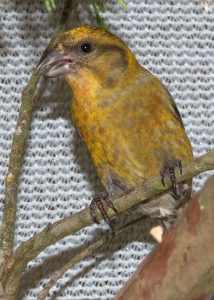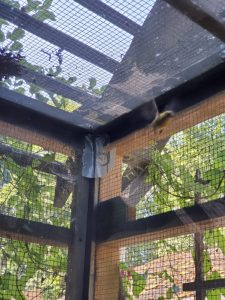Support Us
Since 1979 more than 140,000 animals have been treated by Wildlife Rescue.
Thanks to the support of individuals like you, Wildlife Rescue can provide a lifeline for animals in distress.
Conifer Feeding Bird found Year-Round!
Spotted in British Columbia year-round, Red Crossbills are beautiful birds. Male Red Crossbills can be easily identified due to the sharp red colour of their feathers, the females, with their yellow and olive-brown colour, are not as noticeable.
These small birds tend to eat an assortment of foods ranging from seeds (such as the seeds of spruce, pine, and hemlock trees) and insects in early summer.
Like many other birds in British Columbia, female Red Crossbills create nests out of twigs from conifer trees and line the inside with materials such as needles, feathers, and hair. They tend to place their nests especially high up – up to 70 ft in the air – near thick foliage by the trunk of the tree. These incredible birds are monogamous and tend to nest in spring but will breed in late summer through fall or from late winter to early spring.

Slow Recovery Post Window Strike
Unfortunately, these birds face many threats in the wild – some natural, some caused by humans. Recently, a female Red Crossbill was transferred to Wildlife Rescue hospital from a local veterinary clinic. An unknown finder dropped the weak bird at the clinic with little information for assessment. Luckily, the clinic promptly reached out to our experts to seek appropriate medical attention.
Wildlife Rescue staff found the injured bird had severe head trauma, slow reactionary response, and was emaciated. A health assessment plan for the injured bird would focus on alleviating pain and focusing on healing from the bruising and trauma. Staff and volunteers are working hard to provide supportive care and medication to reduce the pain and swelling.

Windows Create Illusion
Birds fly towards glass windows for several reasons – the reflection of the skyline, visible vegetation, or simply believing it to be an open space to fly through.
Placing decals, stickers, or dark tape along windows is a popular option. It is recommended to have roughly the space of a hand between the items to maximize coverage and discourage the birds from approaching.
If you are concerned about occupying too much space and still want a clear view out the window, look for options that are ultraviolet as they are near-invisible to humans and still visible to birds.
Another common problem is the fact that they are losing their habitat to logging and development. Red Crossbills rely heavily on conifer trees since they eat the seeds and use these trees to nest – but as we lose more and more of these trees every year, we are also losing this precious species. As well, Crossbills often forage near roads – which can lead to them getting sick from ingesting the chemicals used to keep roads clear during winter or getting hit by a car.
Tips to help the Red Crossbill thrive!
Of course, there are many ways for us to help these precious birds here is how you can help today..
Helping Red Crossbills in need is another way to keep them safe. If you see a bird that has exposed bone or blood, bugs or insects covering it, no feathers, or a bird that is sleeping, human intervention is required. Please contact our Support Centre for assistance. Red Crossbills need our help, so simple lifestyle changes are a great way to keep these birds safe.
Yes, I want to support the Red Crossbill today!